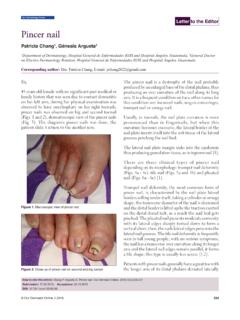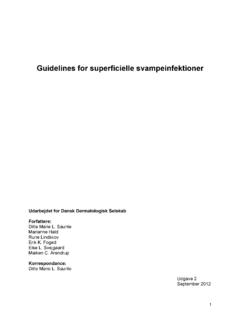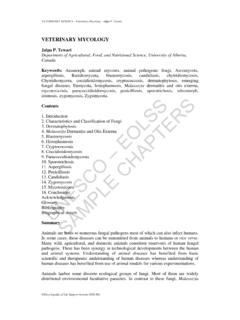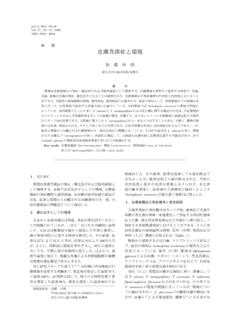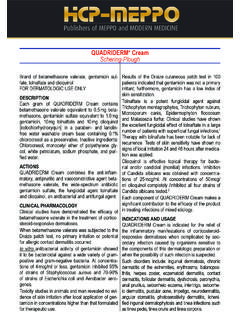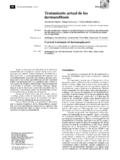Transcription of Corresponding author: Prof. Pramod Kumar Nigam, E-mail ...
1 Our Dermatol Online 2122XU 'HUPDWRORJ\ 2 QOLQHA ntifungal drugs and resistance: Current conceptsPramod Kumar NigamDepartment of Dermatology, STD & Leprosy, Pt. J. N. M. Medical College, Raipur-492001, (CG), IndiaCorresponding author: Prof. Pramod Kumar nigam , E-mail : dermatophytoses affecting skin, hair and nail are among the most common public health problem in hot and humid climate of tropical countries like India. Cutaneous mycoses are mostly caused by keratinophilic filamentous fungi called dermatophytes and are classified into three genera: Trichophyton, Microsporum and Epidermophyton. So far, about 30 species of dermatophytes have been identified as human pathogens [1].Although infections caused by dermatophytes are generally limited to the surface regions of the skin, these fungi can behave in a manner invasive, causing deeper and disseminated infection, especially in immunocompromised patients [2].
2 World Health Organization estimates dermatophytes affect about 25% of the world population [3]. It is also estimated that 30 to 70% of adults are asymptomatic carriers of these pathogens, and that the incidence of this disease increases with age [3]. The estimated life-time risk of acquiring dermatophytosis is between 10 and 20 percent [4]. Climatic factors, as well as social practices, population migration and individual characteristics, such as immune status, may affect the epidemiology of dermatophytosis [3]. In addition, some risk factors have also been associated with onychomycosis, such as age, morphological abnormalities in the nails, genetic factors, poor hygiene conditions and some diseases such as diabetes mellitus and immunodeficiency frames [4,5].
3 The most common dermatophytes that cause cutaneous mycoses are Trichophyton rubrum, Trichophyton mentagrophytes, Microsporum canis and Trichophyton tonsurans [6]. Among the fungi isolated from skin infections, the anthropophilic dermatophyte T. rubrum is the most frequent amongst clinical cases of tinea pedis, tinea unguium, tinea corporis and tinea Review ArticleABSTRACTR ecently, clinical failure and relapses have been observed in patients treated with antifungals. Drug resistance has become an important problem leading to significant negative social, psychological, and occupational health effects and quality of life. Early recognition and treatment is essential to reduce morbidity and possibility of transmission. The increased use, inappropriate prescribing and over the counter sale of antifungal agents has also added in the development of resistance to these drugs.
4 The main biochemical and molecular mechanisms that contribute to antifungal resistance include reduced uptake of the drug, an active transport out of the cell or modified drug metabolic degradation of the cell, changes in the interaction of the drug to the target site or other enzymes involved in the process by point mutations, overexpression of the target molecule, overproduction or mutation of the target enzyme, amplification and gene conversion (recombination), and increased cellular efflux and occurrence of biofilm. Although, there is considerable knowledge concerning the biochemical, genetic and clinical aspects of resistance to antifungal agents, expansion of our understanding of the mechanisms by which antifungal resistance emerges and spreads, quicker methods for the determination of resistance, targetting efflux pumps, especially ATP binding cassette (ABC)
5 Transporters and heat shock protein 90, new drug delivery systems, optimizing therapy according to pharmacokinetic and pharmacodynamic characteristics, new classes of antifungal drugs that are active against azole-resistant isolates, and use of combinations of antifungal drugs or use of adjunctive immunostimulatory therapy and other modalities of treatment will clearly be important for future treatment strategies and in preventing development of words: Antifungal, Resistance, Mechanism, Efflux pump, MeasuresHow to cite this article: Antifungal drugs and resistance: Current concepts. Our Dermatol Online. 2015;6(2) : ; Acceptance: : Our Dermatol Online 213cruris [4].
6 While Trichophyton tonsurans was the most likely etiologic agent in cases with tinea capitis [7]. T. rubrum accounted for 76 percent of all superficial fungal diseases in a representative sample of the population [7]. Epidemiological studies on occurrence of dermatophytes have also shown that T. rubrum is present in 80% of cases and T. mentagrophytes in 20% [8]. Among onychomycosis also, T. rubrum is the most prevalent dermatophyte and affects children and adults in about of the cases identified, followed by T. mentagrophytes in cases [9]. In a study conducted over a period of three years, Bright et al reported the isolation of dermatophytes in of cases of onychomycosis, and T. rubrum isolated in of patients and T.
7 Tonsurans and T. mentagrophytes and of subjects, respectively [10].Mycoses may have significant negative social, psychological, and occupational health effects and can compromise the quality of life significantly. Early recognition and treatment is essential to reduce morbidity and possibility of transmission. Treatment of dermatophytosis is generally long and costly. Dermatophytoses are often associated with relapses following the interruption of antifungal therapy. Recently, clinical failure has been observed in patients treated with antifungals and drug resistance has become an important problem. Although the prevalence of drug resistance in fungi is below that observed in bacteria, mycologists now believe that selective pressure will, over time, lead to more widespread resistance [11].
8 ANTIFUNGAL DRUGS AND THEIR MECHANISM OF ACTIONThe fungal cell wall is composed of multiple layers where mannoproteins and glucan make up more than 80% of the cell wall composition, while chitin represents less than 2% [12]. Mannoproteins are predominantly expressed at the external surface. The plasma membranes of fungi are primarily composed of ergosterol [12]. Keratinocytes are the most numerous cells in the epidermis, forming a physical barrier to micro-organisms and mediate the immune response [3]. Keratinocytes secrete various soluble factors capable of regulating the immune response, such as growth factors [basic fibroblast growth factor (bFGF), transforming growth factor (TGF- , TGF- ), tumor necrosis factor, interleukins (IL- 1, IL-3, IL-6, IL-7, IL8), and colony stimulating factors [13].]
9 Recent studies have demonstrated that keratinocytes have a different profile of cytokine expression when stimulated by different species of dermatophytes [3]. It was shown that Arthroderma benhamiae, a zoophilic and teleomorph of dermatophyte T. mentagrophytes, induces the expression of several cytokines by keratinocytes which may be involved in triggering an inflammatory response typical of these infections [14]. Both topical and systemic therapies may be used to treat dermatophyte infections. The binding and synthesis of ergosterol, the major cell membrane component, are the targets for several antifungal structures. Topical therapy is generally effective for uncomplicated tinea corporis of small areas and of short duration [15].
10 Antifungals are grouped on the basis of their structure and mechanism of action: The azoles and triazoles interfere with the ergosterol biosynthesis pathway by inhibiting cytochrome P450-dependent 14--demethylase and blocking the oxidative removal of 14--methyl from lanosterol resulting into the structural changes in the lipid membrane. They are directed against lanosterol 14-alpha-demethylase, a cytochrome P-450 enzyme containing a heme moiety in its active site, in the ergosterol pathway. Azoles have also been reported to inhibit membrane-surface enzymes and lipid biosynthesis [12]. Azoles, include imidazoles (ketoconazole and miconazole) and triazoles (fluconazole, itraconazole, and voriconazole).
